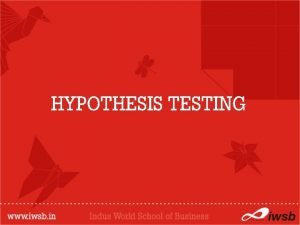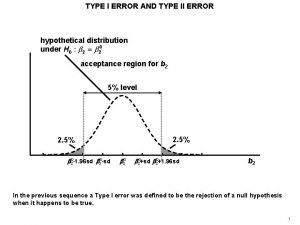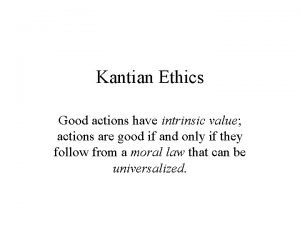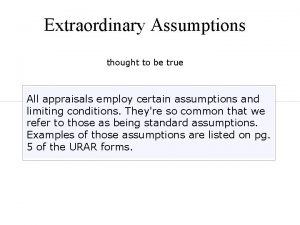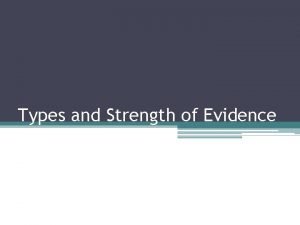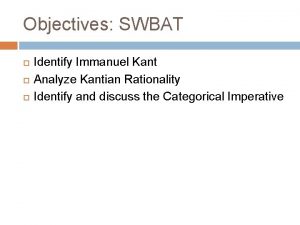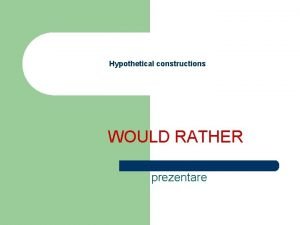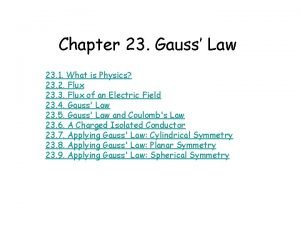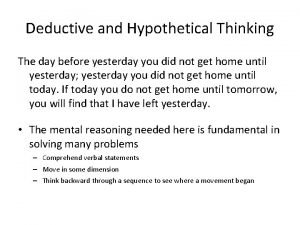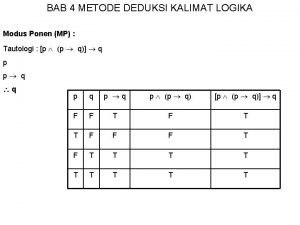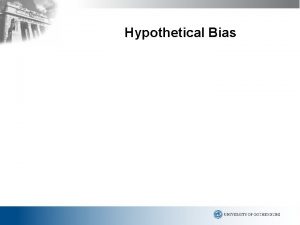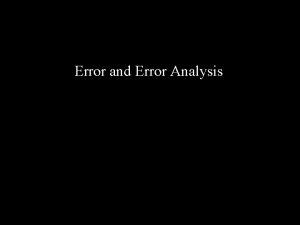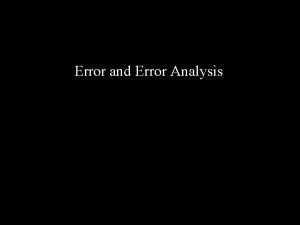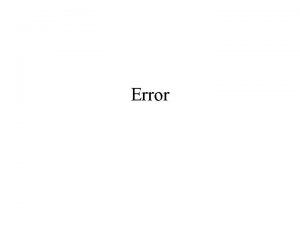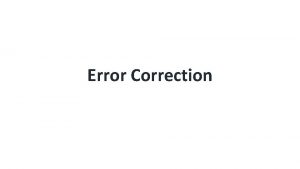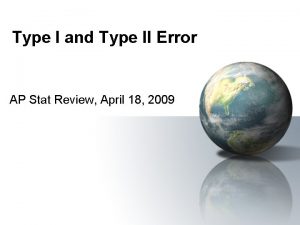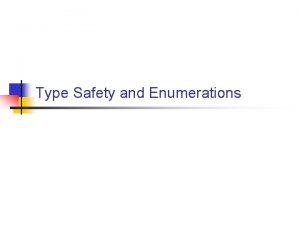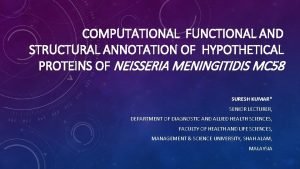TYPE I ERROR AND TYPE II ERROR hypothetical



















- Slides: 19

TYPE I ERROR AND TYPE II ERROR hypothetical distribution under acceptance region for b 2 5% level 2. 5% b 20 -1. 96 sd b 20 -sd b 20+sd b 20+1. 96 sd b 2 In the previous sequence a Type I error was defined to be the rejection of a null hypothesis when it happens to be true. 1

TYPE I ERROR AND TYPE II ERROR hypothetical distribution under acceptance region for b 2 5% level 2. 5% b 20 -1. 96 sd b 20 -sd b 20+sd b 20+1. 96 sd b 2 In hypothesis testing there is also a possibility of failing to reject the null hypothesis when it is in fact false. This is known as a Type II error. 2

TYPE I ERROR AND TYPE II ERROR hypothetical distribution under acceptance region for b 2 5% level 2. 5% b 20 -1. 96 sd b 20 -sd b 20+sd b 20+1. 96 sd b 2 This sequence will demonstrate that there is a trade-off between the risk of making a Type I error and the risk of making a Type II error. 3

TYPE I ERROR AND TYPE II ERROR hypothetical distribution under acceptance region for b 2 5% level 2. 5% b 20 -1. 96 sd b 20 -sd b 20+sd b 20+1. 96 sd b 2 The diagram show the acceptance region and the rejection regions for a 5% significance test. The risk of making a Type I error, if the null hypothesis happens to be true, is 5%. 4

TYPE I ERROR AND TYPE II ERROR hypothetical distribution under acceptance region for b 2 1% level 5% level 0. 5% b 20 -2. 58 sd 0. 5% b 20 -sd b 20+sd b 20+2. 58 sd b 2 Using a 1% significance test, instead of a 5% test, reduces the risk of making a Type I error to 1%, if the null hypothesis is true. 5

TYPE I ERROR AND TYPE II ERROR hypothetical distribution under acceptance region for b 2 1% level 5% level 0. 5% b 20 -2. 58 sd 0. 5% b 20 -sd b 20+sd b 20+2. 58 sd b 2 We will consider the implications of the choice of significance test for the case where the null hypothesis happens to be false. 6

TYPE I ERROR AND TYPE II ERROR hypothetical distribution under acceptance region for b 2 1% level 5% level 0. 5% b 20 -2. 58 sd 0. 5% b 20 -sd b 20+sd b 20+2. 58 sd b 2 The diagram above explains how the test decisions are made, but it does not give the actual distribution of b 2. (For that reason the curve has been drawn with a dashed line. ) 7

TYPE I ERROR AND TYPE II ERROR hypothetical distribution under acceptance region for b 2 1% level actual distribution under 5% level 0. 5% b 20 b 21 -2 sd b 21 -sd b 21+sd b 21+2 sd b 2 Suppose that H 1: b 2 = b 21 is in fact true and the distribution of b 2 is therefore governed by the right-hand curve. 8

TYPE I ERROR AND TYPE II ERROR hypothetical distribution under acceptance region for b 2 1% level actual distribution under 5% level 0. 5% b 20 b 21 -2 sd b 21 -sd b 21+sd b 21+2 sd b 2 If we obtain some data and run a regression, the estimate b 2 might be as shown. In this case we would make the right decision and reject H 0, no matter which test we used. 9

TYPE I ERROR AND TYPE II ERROR hypothetical distribution under acceptance region for b 2 1% level actual distribution under 5% level 0. 5% b 20 b 21 -2 sd b 21 -sd b 21+sd b 21+2 sd b 2 Here is another estimate. Again, we would make the right decision and reject the null hypothesis, no matter whether we use the 5% test or the 1% test. 10

TYPE I ERROR AND TYPE II ERROR hypothetical distribution under acceptance region for b 2 1% level actual distribution under 5% level 0. 5% b 20 b 21 -2 sd b 21 -sd b 21+sd b 21+2 sd b 2 In the case shown, we would make a Type II error and fail to reject the null hypothesis, using either significance level. 11

TYPE I ERROR AND TYPE II ERROR hypothetical distribution under acceptance region for b 2 1% level actual distribution under 5% level 0. 5% b 20 b 21 -2 sd b 21 -sd b 21+sd b 21+2 sd b 2 But in the case of this estimate, we would make the right decision if we used a 5% test but we would make a Type II error if we used a 1% test. 12

TYPE I ERROR AND TYPE II ERROR hypothetical distribution under acceptance region for b 2 1% level actual distribution under 5% level 0. 5% b 20 b 21 -2 sd b 21 -sd b 21+sd b 21+2 sd b 2 The probability of making a Type II error if we use a 1% test is given by the probability of b 2 lying within the 1% acceptance region, the interval between the red vertical dotted lines. 13

TYPE I ERROR AND TYPE II ERROR hypothetical distribution under acceptance region for b 2 1% level actual distribution under 5% level 0. 5% b 20 b 21 -2 sd b 21 -sd b 21+sd b 21+2 sd b 2 Given that H 1 is true, the probability of b 2 lying in the acceptance region is that area under the distribution for H 1 in the diagram - the pink shaded area in the diagram. 14

TYPE I ERROR AND TYPE II ERROR hypothetical distribution under acceptance region for b 2 1% level actual distribution under 5% level 0. 5% b 20 b 21 -2 sd b 21 -sd b 21+sd b 21+2 sd b 2 If instead we use a 5% significance test, the probability of making a Type II error if H 1 is true is given by the area under the distribution for H 1 in the acceptance region for the 5% test. 15

TYPE I ERROR AND TYPE II ERROR hypothetical distribution under acceptance region for b 2 1% level actual distribution under 5% level 0. 5% b 20 b 21 -2 sd b 21 -sd b 21+sd b 21+2 sd b 2 This is the gray shaded area in the diagram. In this particular case, using a 5% test instead of a 1% test would approximately halve the risk of making a Type II error. 16

TYPE I ERROR AND TYPE II ERROR hypothetical distribution under acceptance region for b 2 1% level actual distribution under 5% level 0. 5% b 20 b 21 -2 sd b 21 -sd b 21+sd b 21+2 sd b 2 The problem, of course, is that you never know whether H 0 is true of false. If you did, why would you be performing a test? 17

TYPE I ERROR AND TYPE II ERROR hypothetical distribution under acceptance region for b 2 1% level actual distribution under 5% level 0. 5% b 20 b 21 -2 sd b 21 -sd b 21+sd b 21+2 sd b 2 If H 0 happens to be true, using a 1% test instead of a 5% test greatly reduces the risk of making a Type I error (you cannot make a Type II error). 18

TYPE I ERROR AND TYPE II ERROR hypothetical distribution under acceptance region for b 2 1% level actual distribution under 5% level 0. 5% b 20 b 21 -2 sd b 21 -sd b 21+sd b 21+2 sd b 2 However, if H 0 is false, using a 1% test instead of a 5% test increases the risk of making a Type II error (you cannot make a Type I error). 19
 Type 1 or type 2 error statistics
Type 1 or type 2 error statistics Type 2 vs type 1 error
Type 2 vs type 1 error Null and research hypotheses
Null and research hypotheses Define testing of hypothesis
Define testing of hypothesis What is the probability of making a type 1 error
What is the probability of making a type 1 error Kant hypothetical imperative
Kant hypothetical imperative Kant theory
Kant theory Categorical imperative ethics
Categorical imperative ethics Kant imperatives hypothetical and categorical
Kant imperatives hypothetical and categorical Extraordinary assumptions and hypothetical conditions
Extraordinary assumptions and hypothetical conditions Anological evidence
Anological evidence Kant first categorical imperative
Kant first categorical imperative Hypothetical imperative
Hypothetical imperative An example of categorical imperative
An example of categorical imperative Hypothetical constructions
Hypothetical constructions Hypothetical reasoning piaget
Hypothetical reasoning piaget Gauss law
Gauss law Second conditional put the verb into the correct tense
Second conditional put the verb into the correct tense Hypothetical thinking definition
Hypothetical thinking definition Contoh deduksi dalam logika
Contoh deduksi dalam logika



